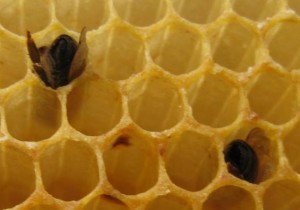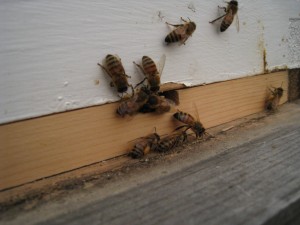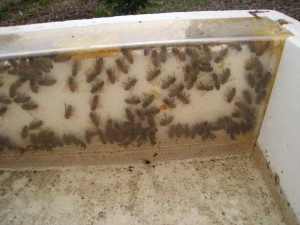Are Your Bees Doing Ok?
As mentioned previously, my periodic hive checks in 2011 have (so far) indicated a nice honey store left on all hives (except the Westover Hive, which I cannot currently check – they moved up to the attic in early January…) But, I will continue to check on them, every time it gets into the low 40’s. The bees have had a cold Winter, following a fairly dry Autumn in the Richmond, Virginia area. They are at risk.

As an example, David Stover, an active Top Bar Hive beekeeper in ERBA, sent me the following email today. He agreed to let me post it here, for the folks that check in. I think it is a great Alert for us all – get out there and have a peak. Make sure your bees have some honey (and if they don’t, David also offers a quick recipe to get some food into the hive.)
I received a call from a beekeeper that had just discovered his hive had died out on Monday. I went over to help him take a look. Almost zero honey. The bees starved and froze. Lots of pollen, not that it did them much good. So this morning I made up a batch of Fondant. Checked my hive at home which had stored up what I thought was way more than enough to see them through the winter and it was almost empty of honey. A few frames with a little capped honey here and there but certainly not enough to make it through. I smeared fondant into the combs of three frames both sides, and the bees were on it pretty quickly. I did see a few frames partially filled with wet nectar so the bees have been collecting nectar somewhere when it has been warm enough.
I checked four other hives and all but one were in the same condition. The one hive that was fairly small had a good amount of capped honey. Just as a precaution I added some fondant to that hive anyway. The smaller hives I went through completely and did not see any signs of brood and not much pollen. All hives now have some fondant to help out.
So if you haven’t checked your hives you might want to take a look this weekend. Sunday is supposed to be in the 50’s and sunny.
Fondant Recipe:
1 part water
4 parts sugar
1/4 teaspoon white vinegar
I also added 1/4 teaspoon Honey-B-Healthy (just because I had some)
Put into big sauce pan. Bring to a boil while stirring the whole time to prevent the sugar from burning. Leave it to a gently boil for 5 more minutes or until it reaches 234 F. test with a candy thermometer if you have one. Take it off the heat and let it sit until it cools to 200 F. With an electric hand held soup mixer or whatever mixer you have beat the mixture until it turns sort of white and has lots of air bubbles in it (took about 5 minutes). Pour into a shall container and let it sit undisturbed until cool.
In Langs you can put it on top of the frames over the brood/cluster in a shall dish or on wax paper. (put some sticks in it so the bees don’t get stuck)
In a TBH I either smear it into empty comb or put it in a shallow narrow plastic dish, cut to fit, and slide it on the floor of the hive as far in as I can get it.


